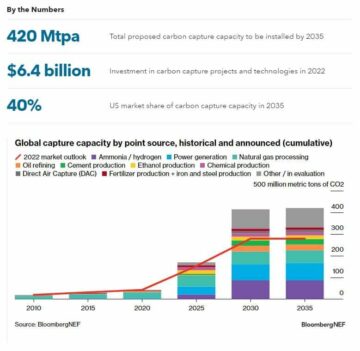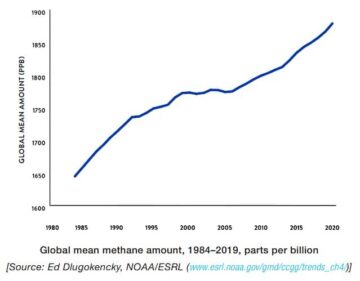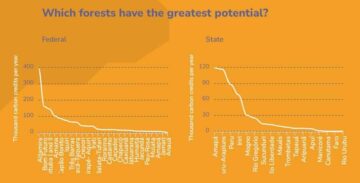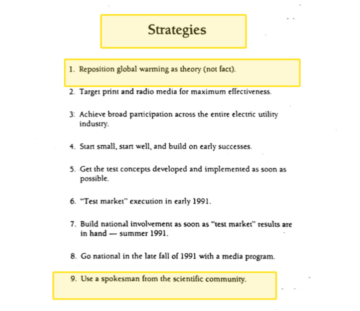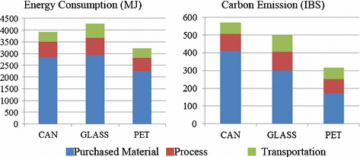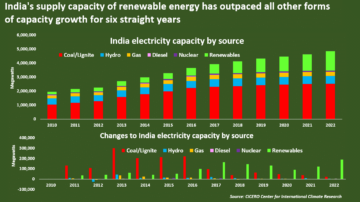Carbon Direct, a carbon management solutions provider, just published a practical buyer’s guide for sustainable biomass sourcing to help mitigate the risks of biomass-based carbon dioxide removal (CDR) contracting.
The guide is a product of collaboration between buyers and Carbon Direct’s expert advisory group with large corporations as signatories, including Microsoft, Shopify, and Stripe. It provides practical insights for CDR agreements while emphasizing the need for stringent standards and oversight for sustainable biomass sourcing.
The report also underscores the potential of biomass-based CDR in fighting global warming and achieving ambitious climate targets. It marks an initial step toward establishing effective safeguards through its four sourcing principles, each with its own criteria.
While not a standard or certification, the report considers multiple implementation pathways, aiming to minimize risk and pave the way for the industry’s expansion.
Mitigating Risks in Biomass-Based CDR Contracting
The biomass-based CDR industry is expanding rapidly in the voluntary carbon markets. And as demand for durable carbon removals grows, biomass-based solutions are at the forefront.
Most of the available supply of highly-durable CDR to date include bioenergy with carbon capture and storage (BECCS), biochar, and other biomass carbon removal and storage (BiCRS). These biomass-based CDR projects can scale rapidly in the next decade, with millions of tonnes of announced offtake agreements already.
Given that the largest biomass-based CDR projects will start storing carbon as early as 2026, the report focuses on tools and frameworks that will be executed within the next few years. This near-term approach is crucial in providing recommendations for seamless integration into contracts involving different biomass-based CDR applications.
Per global projections, the demand for biomass in ambitious decarbonization scenarios could potentially surpass conservative estimates of sustainable, low-lifecycle-emissions supply by a considerable margin, ranging from 11x to 16x by the year 2050.
These studies, while showing varying figures, all underscore the significant disparity between the accessible biomass resource and its various potential applications in a net zero economy. The chart shows the variance between demand and supply of biomass by 2050.
A Mismatch Between Biomass Demand & Supply by 2050
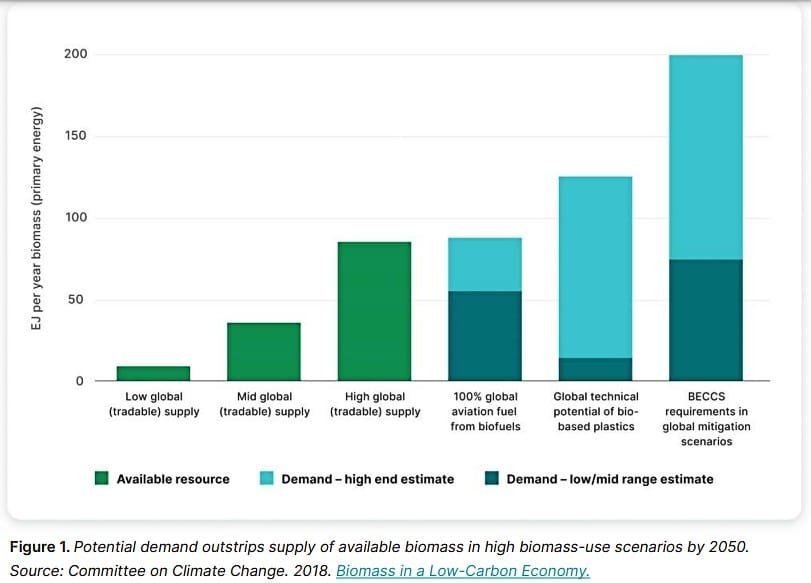

The biggest potential source of new demand for biomass is energy conversion. Some estimates suggest that biomass demand from biopower alone would consume all supply by 2050. These projections emphasize the importance of developing sound guardrails on biomass use before these industries scale up.
This is where the new guidance comes in, providing the guardrails to mitigate the risks of biomass-based CDR contracting. This goal is guided by four core sourcing principles outlined in the document.
The 4 Core Principles for Sustainable Biomass Sourcing
The principles are achievable through the satisfaction of a set of criteria and implementation options as suggested.
Principle #1.

 The criteria for this principle are as follows:
The criteria for this principle are as follows:
- Source certified through an independent, third-party audited forest certification standard; or from areas of low risk (determined by risk-based assessment).
- Source from jurisdictions with robust forest governance or strong oversight of forest certification standards (using the Corruption Perception Index (CPI) and similar resources).
- Biomass must be traceable across the entire supply chain, from the sourcing jurisdiction to point of conversion for carbon removal.
Chain-of-custody (CoC) tracking is often the primary method used to trace products from their source to their final destination.
Principle #2.


Complying with the second principle involves these things:
- Sourcing from wood processing operations with low risk of impact to community’s health,
- Sourcing from forest operations respecting the rights of the Indigenous Peoples (IPs),
- Sourcing from forest operations protecting the economic, social, and environmental well-being of workers.
Principle #3.


The third principle emphasizes the importance of forest protection and preservation with biomass sustainably sourced from:
- Areas not considered as primary forest (per UN FAO definition) or old-growth forest (per national/subnational definition),
- Forest management initiatives that don’t threaten protected areas or High Conservation Value forests (unless harvest is explicitly granted),
- Forest management efforts that preserve or improve ecological functions (e.g. biodiversity, soil health, regeneration, and nutrient cycling),
- Areas where forest stocks are in steady-state or growing.
Principle #4:


This last principle focuses on biomass sourcing that doesn’t compete with existing agricultural or forestry products. The biomass must be:
- A by-product of non-energy products or services,
- From wood that can be accounted for existing economical counterfactual biomass uses (carbon storage) to understand the real carbon benefits of biomass,
- Not from plantation forests developed within the past 2 decades (except previously used for agricultural purposes for ten or more years).
Each criterion is accompanied by a comprehensive explanation in the guide. The criteria provided seek to provide specific, measurable outcomes, with multiple implementation options for flexibility.
Though the report considers the most conservative option as “preferred”, it emphasizes the potential for customized oversight in specific cases. It particularly depends on certain factors at play in specific area.
Finally, buyers should take into consideration any trade-offs between practical and conservative approaches when adopting the recommended options into their biomass-based CDR offtake agreements.
Below is the list of the prominent voluntary and regulatory certification schemes that certify forest biomass provided in the guide.
Biomass Certification Schemes
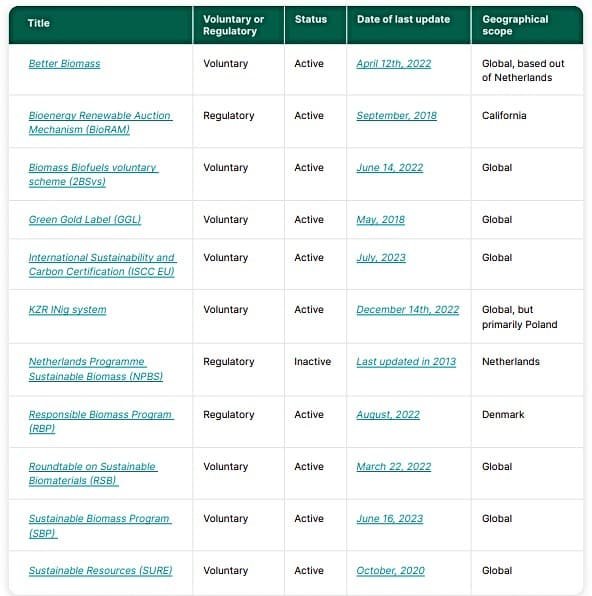

As the biomass-based CDR industry continues to expand, establishing effective safeguards and standards for sustainable biomass sourcing is crucial. Carbon Direct’s buyer’s guide provides comprehensive insights and principles for mitigating risks and ensuring responsible sourcing practices.
By emphasizing the necessity of stringent oversight and sustainable biomass sourcing, the guide paves the way for the industry’s sustainable growth and underscores its significant role in global climate action.
- SEO Powered Content & PR Distribution. Get Amplified Today.
- PlatoData.Network Vertical Generative Ai. Empower Yourself. Access Here.
- PlatoAiStream. Web3 Intelligence. Knowledge Amplified. Access Here.
- PlatoESG. Carbon, CleanTech, Energy, Environment, Solar, Waste Management. Access Here.
- PlatoHealth. Biotech and Clinical Trials Intelligence. Access Here.
- Source: https://carboncredits.com/sustainable-biomass-sourcing-a-buyers-guide-for-biomass-based-cdr-contracting/
- :is
- :not
- :where
- $UP
- 1
- 125
- 2026
- 2050
- a
- accessible
- accompanied
- accounted
- achieving
- across
- Action
- Adopting
- advisory
- agreements
- Agricultural
- Aiming
- All
- alone
- already
- also
- ambitious
- an
- and
- announced
- any
- applications
- approach
- approaches
- ARE
- AREA
- areas
- AS
- assessment
- At
- audited
- available
- BE
- before
- benefits
- between
- Biggest
- biochar
- biomass
- BUYER..
- buyers
- by
- CAN
- capture
- carbon
- carbon capture
- carbon dioxide
- cases
- certain
- Certification
- Certified
- certify
- chain
- Chart
- Climate
- climate action
- collaboration
- comes
- compete
- comprehensive
- CONSERVATION
- conservative
- considerable
- consideration
- considered
- considers
- consume
- continues
- contracting
- contracts
- Conversion
- Core
- Corporations
- Corruption
- could
- CPI
- criteria
- crucial
- customized
- data
- Date
- decade
- decades
- decarbonization
- definition
- Demand
- depends
- destination
- determined
- developed
- developing
- different
- direct
- document
- Doesn’t
- Dont
- e
- each
- Early
- Ecological
- Economic
- economy
- Effective
- efforts
- emphasize
- emphasizes
- emphasizing
- energy
- ensuring
- Entire
- environmental
- establishing
- estimates
- Ether (ETH)
- Except
- executed
- existing
- Expand
- expanding
- expansion
- expert
- explanation
- explicitly
- factors
- few
- fighting
- Figures
- final
- Flexibility
- focuses
- follows
- For
- forefront
- forest
- four
- frameworks
- from
- functions
- Global
- global warming
- goal
- governance
- granted
- Group
- Growing
- Grows
- Growth
- guidance
- guide
- guided
- harvest
- Health
- help
- High
- http
- HTTPS
- Impact
- implementation
- importance
- improve
- in
- include
- Including
- independent
- index
- industries
- industry
- industry’s
- initial
- initiatives
- insights
- integration
- into
- involves
- involving
- IT
- ITS
- jpg
- jurisdiction
- jurisdictions
- just
- large
- largest
- Last
- List
- Low
- management
- Margin
- max-width
- method
- Microsoft
- millions
- minimize
- Mitigate
- mitigating
- mitigating risks
- more
- most
- multiple
- must
- necessity
- Need
- New
- next
- of
- often
- on
- Operations
- Option
- Options
- or
- Other
- outcomes
- outlined
- outstrips
- Oversight
- own
- particularly
- past
- pathways
- pave
- per
- perception
- plantation
- plato
- Plato Data Intelligence
- PlatoData
- Play
- Point
- potential
- potentially
- Practical
- practices
- previously
- primary
- principle
- principles
- processing
- Product
- Products
- projections
- projects
- prominent
- protected
- protecting
- protection
- provide
- provided
- provider
- provides
- providing
- published
- purposes
- ranging
- rapidly
- real
- recommendations
- recommended
- regeneration
- regulatory
- removal
- report
- resource
- Resources
- respecting
- responsible
- rights
- Risk
- risks
- robust
- Role
- s
- safeguards
- satisfaction
- Scale
- scenarios
- schemes
- seamless
- Second
- Seek
- Services
- set
- Shopify
- should
- showing
- Shows
- Signatories
- significant
- similar
- Social
- soil
- Solutions
- some
- Sound
- Source
- sourced
- Sourcing
- specific
- standard
- standards
- start
- Step
- Stocks
- storage
- stringent
- stripe
- strong
- studies
- suggest
- supply
- supply chain
- surpass
- sustainable
- Sustainable Growth
- sustainably
- Take
- targets
- ten
- that
- The
- their
- These
- things
- Third
- third-party
- this
- threaten
- Through
- to
- tools
- toward
- trace
- traceable
- Tracking
- UN
- underscore
- underscores
- understand
- use
- used
- uses
- using
- value
- various
- varying
- voluntary
- W3
- Way..
- webp
- when
- while
- will
- with
- within
- wood
- workers
- would
- year
- years
- zephyrnet

